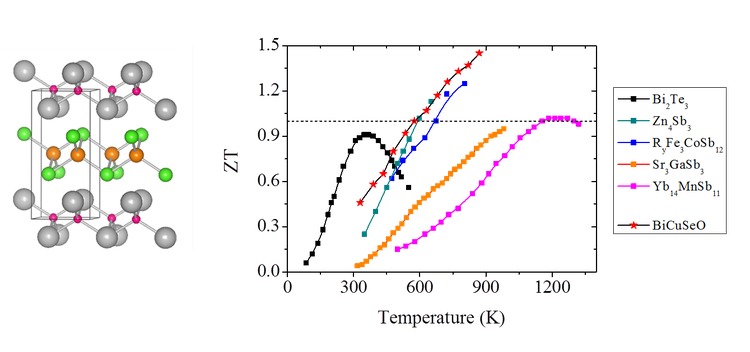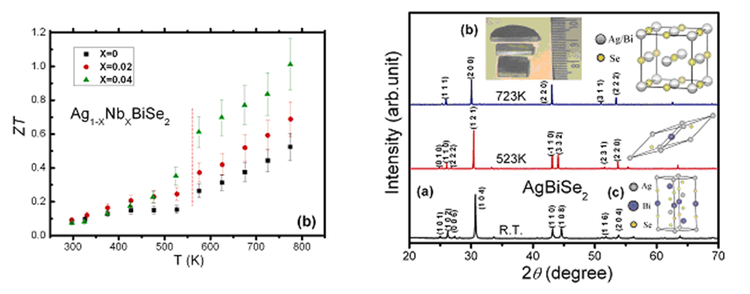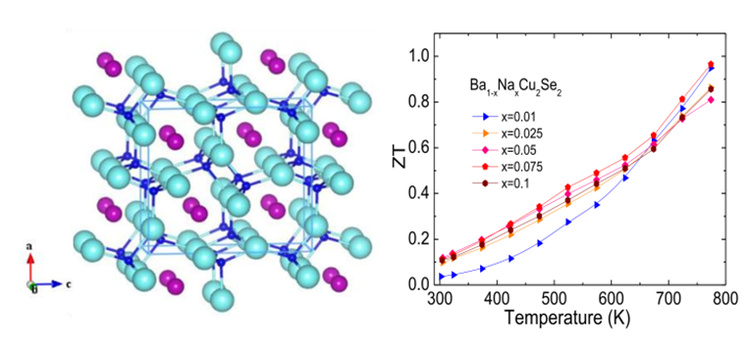Development of new thermoelectric materials
One of our research activities is devoted to the development and optimisation of new efficient thermoelectric materials that stand out of "conventional" intermetallic alloys that are used in current applications. During the past few years, we have evidenced several families of materials that show a good potential for applications in thermoelectric modules. Some of them are described below.
contacts : David Bérardan, Céline Roux-Byl, Nita Dragoe, Nghi Pham
The most promising family of materials whose thermoelectric properties have been evidenced in our group belongs to the oxychalcogenides, with parent compound BiCuSeO. The crystal structure of these materials, which had been studied in the 1990s for applications in the field of optoelectronic, is the same as that of iron-based superconductors with parent compound LaFeAsO. Pristine BiCuSeO is a medium band gap semiconductor, with a low concentration of carriers. Upon appropriate doping, it exhibits a large thermopower coupled to a moderate electrical resistivity. However, its electrical transport properties remain moderate as compared to that of the best thermoelectric materials. This interesting characteristic that makes these materials very promising is their intrinsically very low thermal conductivity, which is much lower than the values generally found in conventional thermoelectric materials. Therefore, BiCuSeO-based materials exhibit very large values of the thermoelectric figure of merit, as shown in the following figure. These values are among the best ever observed to date in bulk polycristalline p-type materials that do not contain lead or tellurium (two elements that we wish to avoid as they preclude any large scale applications), in the temperature range 400-650°C. Besides, we have also shown that these materials can be synthesized using "simple" scalable processes, and that they are stable under inert atmosphere at the temperature of possible applications.

Selected publications:
- “Bi1-xSrxCuSeO oxyselenides as promising thermoelectric materials”, Applied Physics Letters 97, 092118 (2010) (first paper showing the potential of these materials for thermoelectric applications)
- "A high thermoelectric figure of merit ZT > 1 in Ba heavily doped BiCuSeO oxyselenides", Energy & Environmental Science 5, 8543 (2012) (first publication with ZT > 1 in this family of materials)
- "Texturation boosts the thermoelectric performance of BiCuSeO oxyselenides", Energy & Environmental Science 6, 2916 (2013) (beneficial role of texturation, ZT = 1.4)
- "Realization of n-type and enhanced thermoelectric performance of p-type BiCuSeO by controlled iron incorporation", Journal of Materials Chemistry A 6, 13340 (2018) (ZT = 1.5 in p-type, observation of n-type)
Among the other families whose promising thermoelectric properties have been shown in our group in the past few years, we can mention:
I-V-VI chalcogenides, with parent compound AgBiSe2. Although I-V-VI chalcogenides have been studied for long for their potential application in thermoelectric modules (they are a basic component of TAGS and LAST alloys), AgBiSe2 -based ones had been hardly studied. Contrary to most I-V-VI chalcogenides, that exhibit p-type electrical behavior, AgBiSe2 -based materials can be p-type or n-type depending on the doping strategy, with the best performances observed in n-type compounds. Similarly to BiCuSeO, their electrical transport properties are significantly lower than that of state-of-the-art materials, but they are counterbalanced by intrinsically very low values of the thermal conductivity, which leads to promising thermoelectric performances in the temperature range 450-550°C (following figure, left part). Besides their thermoelectric properties, these materials are also interesting from the point of view of materials chemistry, as they exhibit several structural transitions that can be tuned by isovalent or aliovalent substitution and that strongly influence the electrical and thermal transport behavior (following figure, right).

Selected publications:
- High thermoelectric properties of n-type AgBiSe2”, Journal of the American Chemical Society 135, 4914 (2013) (first paper showing the potential of these materials for thermoelectric applications)
From a chemical point of view, BaCu2Se2 is related to BiCuSeO. As mentionned above, the crystal structure of BiCuSeO is the same "1111" structure as that of LaFeAsO, with a stacking of La2O2 and Fe2As2 layers. In the case of LaFeAsO, the La2O2 layer can be replaced by a 2+ cation while maintaining the electroneutrality, for example Ba2+, to form the "122" family with a similar 2D stacking. In the case of BiCuSeO, a similar structural design would lead to BaCu2Se2. However, the layered structure is not maintained in that case, and this compound cristallizes in a complex crystal structure with a rigid framework of CuSe4 tetrahedra forming 1D channels, and Ba2+ cations that lie within the channels (following figure, left). BaCu2Se2 is a large band gap p-type semiconductor. Silimarly to BiCuSeO and AgBiSe2, moderate electrical properties are counterbalanced by intrinsically very low values of the thermal conductivity, leading to promising thermoelectric performances (following figure, right).

Selected publications:
- “BaCu2Se2 based compounds as promising thermoelectric materials”, Dalton Transactions 44, 2285 (2015) (first paper showing the potential of these materials for thermoelectric applications)

